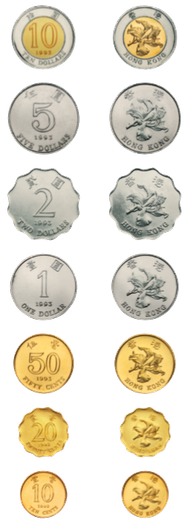Top Qs
Timeline
Chat
Perspective
Coins of the Hong Kong dollar
From Wikipedia, the free encyclopedia
Remove ads
The Hong Kong coinage, including 10¢, 20¢, 50¢, $1, $2, $5 & $10, is issued by Hong Kong Monetary Authority on behalf of the Government of Hong Kong. From 1863 until 1992, these coins were embossed with the reigning British monarch's effigy. Since 1 January 1993, a new series depicting the bauhinia flower was gradually issued, including a new denomination of $10. Since the beginning of the coin replacement programme on 1 January 1993, over 585 million coins featuring Queen Elizabeth II have been withdrawn from circulation. However, these coins remain legal tender. The total value of coins in circulation in Hong Kong can be found in Monthly Statistical Bulletin and the Annual Report.

Remove ads
Historical denominations
Summarize
Perspective
Discontinued denominations
The following coin denominations are no longer circulated by the HKMA.
- The 1 mill coin was discontinued due to its unpopularity.
- 1 cent last issued in 1934, but the last mintage which was melted down by the Japanese or lost was dated 1941.
- The 5 cent coin was last issued in 1979 and minted for uncirculated coin sets in 1988.
Denominations with specifications changed
The following current denominations that have changed in size, shape, and or metal content.
Remove ads
Coins in circulation before 1992
Summarize
Perspective


Queen Victoria series (1866–1901)
King Edward VII series (1902–1910)
King George V series (1911–1936)
King George VI series (1937–1951)
Queen Elizabeth II series (1952–1992)
Remove ads
Coins in circulation since 1993
Summarize
Perspective
Since the introduction of the Octopus card in 1997, small value payments and purchases in Hong Kong are mostly made as Octopus transactions. The Hong Kong Monetary Authority did not issue any new coinage from 1998 to 2011 as the territory had stored enough for use. The increased consumption of coins in the territory since 2004 would influence the Hong Kong Monetary Authority to resume minting coins in 2012.[1]
The obverse of newer coin bear the standard bauhinia, with the word "Hong Kong" in Chinese characters and English. The reverse features the denomination in Chinese characters and English with a large Arabic numeral in the centre and the year of issue below.
Security features
The $10 coin is made of two metals: a white nickel alloy outer ring and a brass inner core. The standard bauhinia on the obverse gives a sharp embossed image. The neat bonding between the outer and inner rings gives it another unique feature. The $10 coin has an alternate plain and milled edge. The $5 coin has a milled edge. A groove running within the milled edging contains raised English and Chinese characters, which read "Hong Kong Five Dollars". The $1 and 50¢ coins have simple milled edges. The $2 and 20¢ coins have scalloped edges. The 10¢ coin has a plain edge. Under Hong Kong law (sections 98 – 102 of Cap. 200), anyone who makes or possesses or controls or passes any counterfeit note or coin commits an offense and is liable on conviction to imprisonment for up to 14 years.
Remove ads
Commemorative coins and coin sets
Summarize
Perspective
Commemorative coins issued before 1997
- Lunar Zodiac Animal coin set, 1976–1986
- Royal Visit, 1975
- Royal Visit, 1986
- Proof Coin Collection, 1988
Commemorative coins issued after 1997
Opening of the Lantau Link, May 1997
To mark the opening of the Lantau Link, the HKMA issued a philatelic numismatic cover in May 1997, the first of its kind in Hong Kong. The Lantau Link is the first road link between Lantau Island, where the new airport is located, and the rest of Hong Kong.
Establishment of the Hong Kong Special Administrative Region, July 1997
To commemorate the establishment of the Hong Kong Special Administrative Region on 1 July 1997, the HKMA, on behalf of the Government, issued a HK$1,000 commemorative proof gold coin, 97,000 proof sets and an unknown number of brilliant uncirculated set of seven coins with the same denominations as the coins currently in circulation. On the obverse side of each of these seven coins is the standard Bauhinia design, with a special commemorative design and denomination on the reverse.[2]
Opening of the Hong Kong International Airport, July 1998
To mark the opening of the Hong Kong International Airport in July 1998, 15,000 $1,000 commemorative proof gold coin was issued. The gold coin features a design symbolising Hong Kong's ascent into the new century and bears the standard Bauhinia design on the obverse side.
The Five Blessings Commemorative Coin Set, February 2002
To mark the fifth year of the establishment of the Hong Kong Special Administrative Region, the HKMA, on behalf of the Government, issued 60,000 limited edition coin set that consists of five HK$50 silver coins with a gold-plated inner core, and a 9999 pure gold medallion. The five silver coins are individually engraved with a phrase and symbol of traditional blessing.
Remove ads
Coins sources
List of mints that issued Hong Kong's coins in the past:[3]
- Royal Mint, London
- Royal Mint, Hong Kong branch
- James Watt and Company Soho, Birmingham
- R. Heaton and Sons Limited (now The Mint, Birmingham Limited)
- King's Norton Metal Company Limited
References
Wikiwand - on
Seamless Wikipedia browsing. On steroids.
Remove ads